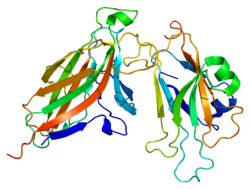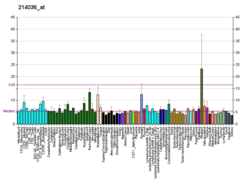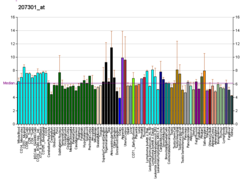Ephrin A5 is a protein that in humans is encoded by the EFNA5 gene.[5][6][7]
Ephrin A5 is a glycosylphosphatidylinositol (GPI)-anchored protein of the ephrin-A subclass of ephrin ligands that binds to the EphA subclass of Eph receptors. Ephrin A5 has also been shown to bind to the EphB2 receptor.[8]
- ^ a b c GRCh38: Ensembl release 89: ENSG00000184349 – Ensembl, May 2017
- ^ a b c GRCm38: Ensembl release 89: ENSMUSG00000048915 – Ensembl, May 2017
- ^ "Human PubMed Reference:". National Center for Biotechnology Information, U.S. National Library of Medicine.
- ^ "Mouse PubMed Reference:". National Center for Biotechnology Information, U.S. National Library of Medicine.
- ^ Cerretti DP, Copeland NG, Gilbert DJ, Jenkins NA, Kuefer MU, Valentine V, Shapiro DN, Cui X, Morris SW (Sep 1996). "The gene encoding LERK-7 (EPLG7, Epl7), a ligand for the Eph-related receptor tyrosine kinases, maps to human chromosome 5 at band q21 and to mouse chromosome 17". Genomics. 35 (2): 376–9. doi:10.1006/geno.1996.0371. PMID 8661153.
- ^ Kozlosky CJ, VandenBos T, Park L, Cerretti DP, Carpenter MK (Oct 1997). "LERK-7: a ligand of the Eph-related kinases is developmentally regulated in the brain". Cytokine. 9 (8): 540–9. doi:10.1006/cyto.1997.0199. PMID 9245480.
- ^ "Entrez Gene: EFNA5 ephrin-A5".
- ^ Himanen JP, Chumley MJ, Lackmann M, Li C, Barton WA, Jeffrey PD, Vearing C, Geleick D, Feldheim DA, Boyd AW, Henkemeyer M, Nikolov DB (May 2004). "Repelling class discrimination: ephrin-A5 binds to and activates EphB2 receptor signaling". Nat. Neurosci. 7 (5): 501–9. doi:10.1038/nn1237. PMID 15107857. S2CID 15643420.






